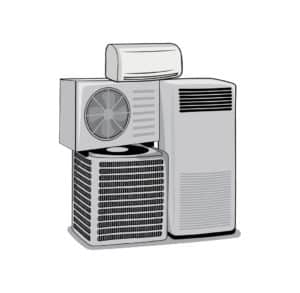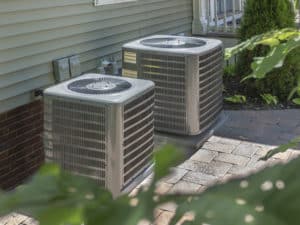
Most of us rely on air conditioning to some degree for much of the year. But what is air conditioning? Many don’t know what it is or how it works. And not understanding air conditioning can lead to us making poor decisions when it comes to buying, using, or servicing air conditioning.
Understanding air conditioning can help you make informed decisions about what situations air conditioning is the best choice and when you might want to consider an alternate cooling technology like an evaporative cooler.
What is air conditioning? There are two main ways in which we use the term: a loose definition and a strict one. The loose definition of air conditioning is that it refers to any method we use to condition the air to make it more comfortable. This could include cooling, dehumidifying, heating, or humidifying. All could potentially fit.
However, the strict definition of air conditioning, as used today, refers specifically to the process of using a heat pump process to cool the air and remove humidity from the air. Ironically, although the coiner of the term “air conditioning” is in dispute, one of the strongest claims is a patent for a process of ventilating a space and adding moisture to the air, more like an evaporative cooler than a modern air conditioner.
Despite this confusion, we’re going to use air conditioning in the strict sense for the rest of this article.
Air conditioning works using some basic principles of physics. We want to make sure everyone’s on the same page before we talk in more detail about how air conditioning works.
Thermodynamics are the basic principles that govern the way heat moves in the universe. It is one of the essential rules of physics that heat moves from areas of high heat density (hot objects and spaces) to areas of low heat density (cold objects and spaces). This is why if you leave your drink on the counter long enough, it eventually becomes room temperature, whether it was hot coffee or a cold beer.
So how can air conditioning keep moving heat from a house that’s already cooler than the outside? It depends on other rules of physics.
In gases, temperature and pressure are related. In general, when the pressure increases, if the volume and the amount of gas stay the same, the heat rises. When the pressure decreases, the temperature decreases.
Evaporation is the process of turning a liquid into a gas. In general, this takes additional energy, usually in the form of heat (think of boiling a kettle on the stove). Condensation is the reverse process, and it gives off energy.
 Before we talk about the air conditioning process as a whole, let’s talk about the components that make up your air conditioning unit.
Before we talk about the air conditioning process as a whole, let’s talk about the components that make up your air conditioning unit.
A compressor is a pump that can take a gas and increase its pressure.
An expansion valve lets gas through in a limited way to maintain a lower pressure on one side than the other.
Cooling fins or coils are lots of small tubes arranged to maximize their surface area. This allows the most efficient exchange of heat between the air conditioner and ambient air.
A blower pushes air over the fins and into an ambient space.
A refrigerant is a substance in the air conditioner that is condensed to a liquid and evaporated to a gas. Theoretically, any ingredient could be used, but some chemicals have the right properties to efficiently go through this process at the range of temperatures and pressures your air conditioning unit can handle. Often, these chemical refrigerants are harmful to people and/or the environment.
Now that we’ve talked about the physics and components of air conditioning, it’s time to put it all together and explain the basic process.
Descriptions of the air conditioning process usually start at the compressor. The compressor increases the pressure of the refrigerant, causing it to condense. Increased pressure concentrates the heat of the refrigerant, making it hotter, and the condensation process releases energy in the form of heat. This hot liquid passes through a series of fins or coils, and a blower uses air to cool the fins. This part of the air conditioner is usually outside, and it releases heat.
The cooled refrigerant then passes through an expansion valve on its way back into the house. The pressure drops, reducing the heat density of the refrigerant and causing the refrigerant to evaporate. The energy for evaporation comes from the heat of the refrigerant and the ambient air, similar to the way an evaporative cooler works. This means that the refrigerant is now cold. From here, the cold refrigerant passes through a set of fins; then, a blower pushes air over the cooling fins. The heat from the air goes into the refrigerant, and the air comes out cooler. Then the refrigerant enters the compressor, and the cycle starts again.
As you can see, air conditioning is a fancy trick. Using a refrigerant that can be easily manipulated to be cool sometimes and hot other times, an air conditioner takes heat from your home and puts it outside (along with the extra heat from the mechanical workings of the machine). This can be very effective when you have a good separation of the hot and the cool sides.
But air conditioning doesn’t work when you can’t effectively separate the two parts of the machine. If, for example, you’re trying to use it outside and there’s no place to put the excess heat.
This is a situation where an evaporative cooler works much better. That’s because an evaporative cooler only uses part of the cycle, the segment where a liquid absorbs heat from the air to evaporate. This cools the air but doesn’t create excess heat that must be dumped somewhere. This process allows an evaporative cooler to work efficiently in situations where you can’t trap the cooled air or separate two parts of an air conditioner unit, making it an effective choice for use outdoors, such as on your patio or for an outdoor restaurant. It also makes it a great choice for spaces that can’t stay closed, such as garages or hangars.
Need to stay cool in a situation where air conditioning is not a good choice? Visit a local or online retailer for a Portacool evaporative cooler today. Have more questions about air conditioning or evaporative coolers? Please contact Portacool online.